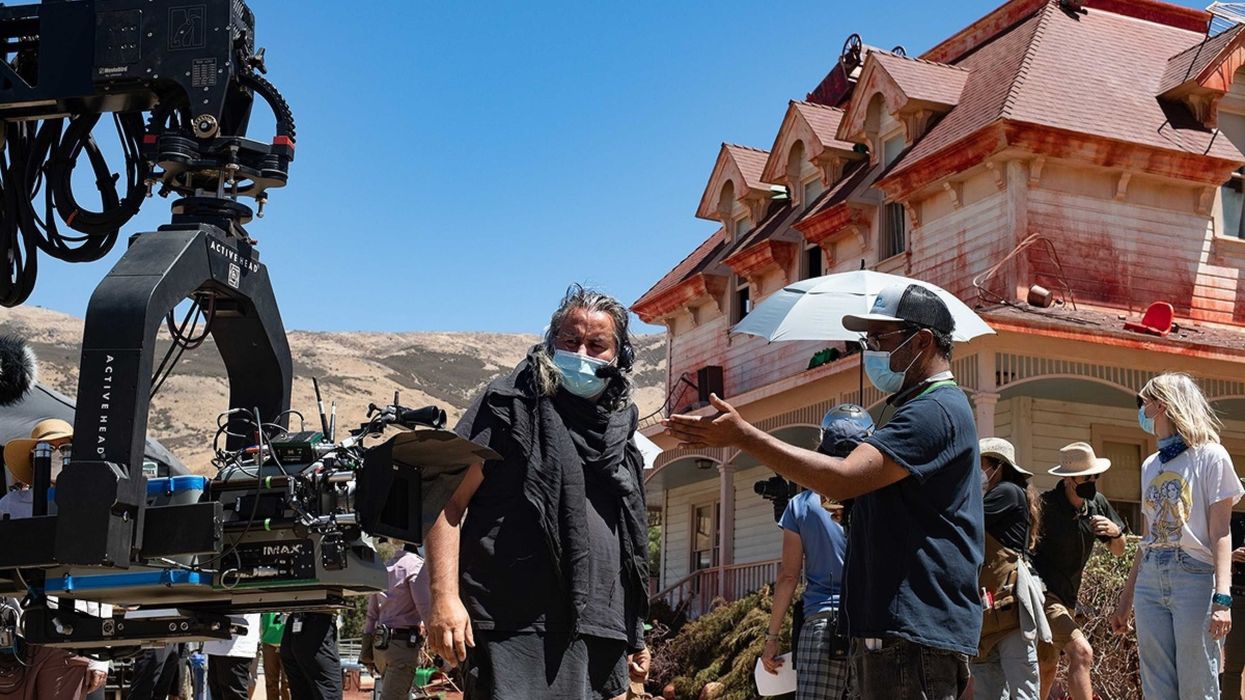How DP Hoyte Van Hoytema Reinvented Day-for-Night in 'Nope'
This cinematographer reinvited the wheel on day-for-night shots, and this is how he did it.

Some of my favorite shots from Jordan Peele’s modern horror classic Nopehappened at the dead of night—or at least what looked like night. From the stillness of a horse looking out into the eerie vastness of a California valley to the entirety of the blood rain sequence, Nope might have some of the best day-for-night shots in all of cinema.
We’ve all heard of day-for-night shots and know how to do them, but Nope‘s cinematographer Hoyte Van Hoytema FSF NSC ACS reinvented how filmmakers will approach shooting day-for-night for the rest of time.
In an interview with Kodak, Van Hoytema breaks down the technical process he and his team endured to shoot convincing night-time sequences with a large format camera.
The New Day-for-Night
Nope provided Van Hoytema with a unique challenge—finding out how to shoot night sequences with no available light.
“One of the major challenges on Nope was how we were going to shoot the night-time sequences, which were mainly all big set pieces,” Van Hoytema said. “When Jordan and I went on the night scouts around Agua Dulce, we saw that there was no available light whatsoever, and realized there was no way we were ever going to be able to light and photograph these large expanses convincingly.”
This wasn’t Van Hoytema’s first time encountering a similar problem. On Ad Astra, Van Hoytema was unable to light up a big area with a single light source during the lunar chase scene. A soft light or double shadows from any source of light would have broken the illusion that the characters were in space.
Van Hoytema came up with a ground-breaking solution to shoot night scenes by creating a new way of shooting day-for-night scenes by using a hybrid of film and digital.
“So with the help of my friend, Kavon Elhami, who runs [the] camera house [CamTec], we purchased two decommissioned 3D-stereo camera rigs on which we could mount two cameras,” Van Hoytema said. “One was an ARRI Alexa, specifically customized to capture infrared, the other a regular 35mm film camera.”
Rather than line up the cameras for 3D parallax, Van Hoytema and Elhami found a way to align the cameras so that both were shooting the exact same image so that “every frame would overlay perfectly later in post-production.”
Infrared cameras are sensitive to very specific wavelengths of light, which is why the images they produce are monochromatic. When shooting natural sunlight with infrared cameras with a slight contrast boost, the images are brightly lit but the skies are dark. By having the 35mm camera that picks up the vital color and texture needed for the image, a perfect composition of the two images comes together in post.

Filming the Night Sequences in Nope
Van Hoytema brought the same idea he had for Ad Astra to Nope, but this time with the ARRI Alexa 65 pointing upwards vertically and shooting in infrared mode, while aligned with a Panavision System 65mm film camera, which was on a horizontal axis.
“However, it’s vitally important that the different gates and lenses are identical, that you have exactly the same depths-of-field, that your focus pulls translate in exactly the same way, and that the two images are completely in-sync,” Van Hoytema said about the camera setup.
Van Hoytema worked closely with Dan Sasaki at Panavision, one of the few companies in LA that owns and maintains a small number of existing 65mm cameras. Sasaki built Van Hoytema a twin set of Panavision Sphero lenses that were used on the cameras.

Close cooperation between ARRI, Panavision, Van Hoytema, and his team at Honeycomb Modular created a specialist rig to solve, as Van Hoytema describes it, “one person’s obsession to do something a little weird and nerdy.”
Although the cameras were ready for production, the rig proved to be weighty and somewhat unbalanced. “We didn’t want to be limited in terms of how we would move the rig around,” said Van Hoytema. The solution was to retrofit a gyro-stabilized Edge crane vehicle to fit the rig.
“They worked really hard to adapt their stabilized head for the rig and all-of-a-sudden, we had the ability to drive everywhere—we could follow running horses and shoot other dramatic action scenes. It became a wonderful, crazy tool that was capable of giving us shot after shot that you might have thought were impossible and probably have never seen before.”

Why Shoot Like Day-for-Night Like This?
When Van Hoytema sat down with colorist Greig Fishes at Company3 to mix the two sets of images, the results were something beautiful and never before seen.
This technique allowed you to look deeper into the darkness of the image.
“When you sit in the cinema, especially in an IMAX theater, and you look around the image, it’s a very, very special immersive experience,” Van Hoytema said about his work.
Shooting with the technique can let you choose what part of the shot is traditional film and what is infrared night photography, giving you more control over the look of your project.
Even though we may not be able to use the expensive tech we see on big summer blockbusters, it is always valuable to know these new techniques that are being introduced to filmmaking and how you can adapt them to fit your project.
What did you think of the night sequences in Nope and Van Hoytema’s approach to them? Let us know in the comments!
Source: Kodak













